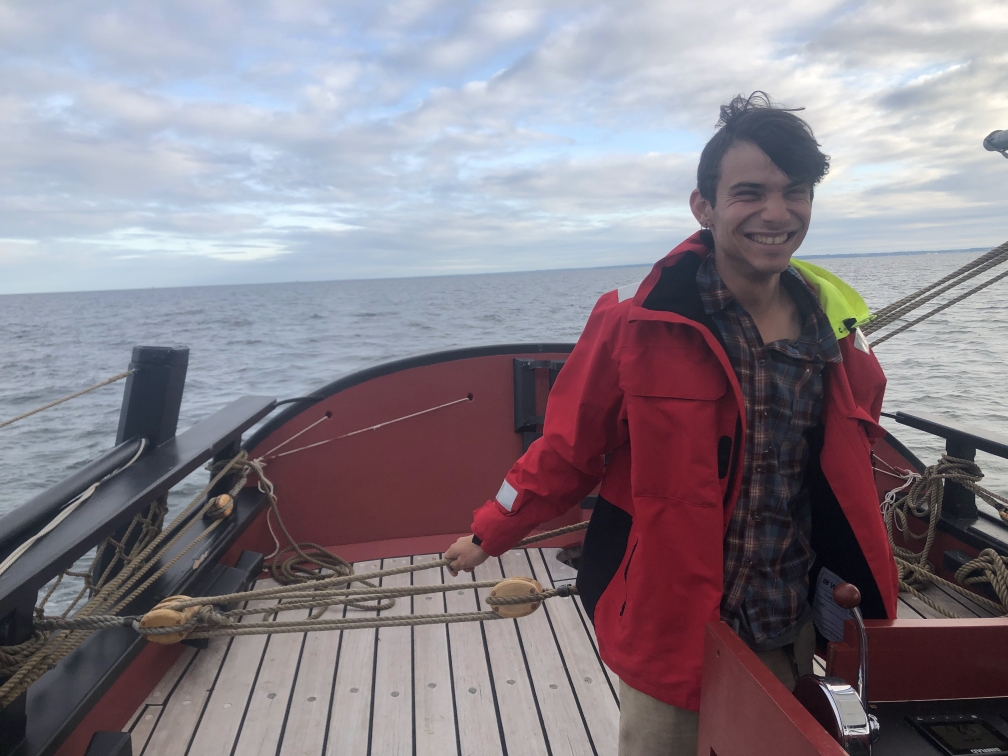Listen in on our interview on Tuesday morning at 9’37 am! Broadcast on Sportsbyline.com
A graduate of Southern Oregon University and a California resident, Darwin has a large background in theater, specifically in directing and leadership roles, teaching young students in organizations including Santa Cruz Parks & Rec Theater and West Creative Performing Arts. After his most recent employment aboard the tall Ship WINDY as a Deckhand Educator, SEF is excited for Darwin to join as a new crew member and continue gaining skills and experience in ship handling and outdoor education.
Launched in 2001, the SEF’S namesake schooner SULTANA is a reproduction of a Boston-built merchant vessel that served for four years as the smallest schooner ever commissioned in the British Royal Navy. The modern SULTANA sails as a school ship, taking more than 4,500 students out onto the Chesapeake Bay each year for hands-on programs in environmental science and history.
SULTANA sails with school systems around the Chesapeake, regularly sailing from ports including Chestertown, Annapolis, Baltimore, St. Michaels, Cambridge, Oxford, Solomons, and Crisfield.
Sultana’s Downrigging Festival: October 27-29, 2023Tall Ships and Bluegrass with a Cause!
Now in its 22nd year, the Sultana Education Foundation’s Downrigging Weekend Festival is one of the largest annual tall ship gatherings in North America. The festival features a long-weekend of Tall Ship sails, tours, incredible live bluegrass music, lectures, exhibits, family activities, regional food and more. Proceeds benefit the Foundation’s environmental literacy programs and the other nonprofits participating in the festival.


HISTORY
The original schooner Sultana’s keel was laid at Benjamin
Hallowell’s shipyard in Boston, Massachusetts in 1767.
Hallowell had been contracted to build Sultana by Sir Thomas
Asquith, a South Hampton merchant who intended to use the
vessel as a combination cargo schooner and yacht. Though small,
measuring just 50 feet 6 inches from stem to stern, she was
nevertheless built as stout as a ship of the line. The schooner’s
solid construction would serve her well, as only months after her
launch into Boston Harbor, Asquith hired a captain and crew to
sail the vessel across the frigid waters of the North Atlantic to the
Royal Navy Yard in Deptford, England, in hopes the Admiralty
would see fit to purchase her.
Prior to Sultana’s arrival in Deptford, the Royal Navy had been
charged with enforcing the newly enacted Townsend Acts. By
authority of the British Parliament and King George III, these
acts imposed duties on tea, paint, paper, lead and other items
imported by the American colonists. Lacking the quick and
maneuverable vessels needed to monitor colonial shipping
effectively, the Royal Navy would, ironically, turn to American
designed and built schooners to augment its fleet. In March of
1768, Royal Navy shipwrights surveyed Sultana and were
favorably impressed.
After the schooner’s purchase, the Royal Navy’s shipwrights
immediately began refitting, arming and provisioning Sultana for
her new life as a revenue cutter in colonial North America.
Topmasts, yards and square sails were added to the original “bare
poled” American rig, bunks were added to accommodate a crew
of twenty-five, and eight half-pound swivel guns were mounted
along the rails. After taking on drinking water and provisions,
Sultana departed England on August 28, 1768, and sailed into the
political firestorm developing in the American colonies.
After a harrowing two-month crossing of the Atlantic, Sultana
arrived in Halifax, Nova Scotia, on October 24, 1768, and was
immediately ordered to Boston Harbor. The tiny schooner soon
found herself part of the largest fleet of war ships ever assembled
in North America, helping to transport thousands of troops sent
to occupy and subdue the rebellious city of Boston. Only twelve
months out of the yard, Sultana was taking part in the first
significant military action of the conflict that would become the
American Revolution.
Sultana’s arrival in Boston also marked the first time one of her
crew members deserted ship in North America. In the confusion
of transporting the British troops to Boston’s long wharf on
November 16, 1768, able-bodied seaman Edward Cunningham
slipped into the crowds gathered to watch the proceedings and
made his escape. While Mr. Cunningham was the first sailor to
run away, he certainly was not the last. Over the course of her
four-year tour of duty, Sultana suffered an annual desertion rate
approaching 100%. A crew that began as a collection of mostly
English and Irish sailors evolved into a diverse mix of British,
European and American-born sailors
While most of the new 1110 American crew members were of European descent, at least one
man, Prince Gould, had ancestors who had been brought to America as slaves from West Africa
With the British troops landed, Sultana left Boston in early
December, 1768. For the next four years, the schooner patrolled
the waters of the Atlantic coast, calling at Boston, New York,
New Jersey, Nova Scotia, Cape Cod, North Carolina, Chesapeake
Bay, Narragansett Bay and Delaware Bay. Sultana’s daily activities
were detailed in logs kept by her commander, Lieutenant John
Inglis, and her Master, David Bruce. These men also maintained
the vessel’s muster books, keeping track of every man who
worked aboard. Amazingly, all of these documents have survived
intact to the present day, providing one of the most authentic and
thoroughly documented histories available for an American-built
vessel of this period.
Sultana patrolled the Chesapeake Bay from October, 1769,
through August, 1770. Master Bruce’s logs from this time period
indicate that the schooner was never busier than when she sailed
the Chesapeake, searching inbound ships from London, Glasgow,
Liverpool, Lisbon, Barbados, Jamaica, Antigua, Port-au-Prince, St.
Christopher’s, Boston, Nantucket, New York and Philadelphia.
In July of 1770, Sultana sailed up the Potomac River, mooring
near Colonel George Washington’s estate at Mount Vernon. On
the evening of July 29th, Lieutenant Inglis and Master Bruce
dined with the future president.
In 1771 and 1772, American sailors were becoming
increasingly intolerant of the Royal Navy’s searches. Lieutenant
Inglis was often forced to fire Sultana’s swivel guns across the bow of ships reluctant to allow a search of their cargo. Occasionally, Sultana was met with violent resistance in the course of her duties.
Sultana’s commander, Lieutenant John Inglis, and her master, David
Bruce, dined with the future general and president George Washington
when Sultana anchored off Mount Vernon in July of 1770.
On January 21, 1771, the schooner had her first significant
encounter with angry American colonists in Newport, Rhode
Island. In response to the seizure of a crew member who had
deserted Sultana, angry citizens took matters into their own hands.
Master David Bruce recorded this event in his log: “The people of
Newport threatened to board us, cut us off (the anchor), and burn the
Schooner” (PRO ADM 52/1455-6). After a tense confrontation
the crowd dispersed and Sultana escaped. On May 9, 1772,
another violent encounter occurred near Newcastle, Delaware,
when the crew of the brig Carolina attempted to recapture their
seized vessel. They were repelled by Lieutenant Inglis’s crew with
grapeshot and musket fire.
With her ability as a warship being tested almost daily, the
Royal Navy decided to recall Sultana from the North American
station. In October, 1772, the schooner sailed back to England
and within a few months of her return she was sold out of the
Royal Navy. Sultana likely spent the twilight of her years as a
merchant ship, sailing the waters off the British Isles.
Though Sultana was neither the largest nor the most powerful
vessel to emerge from an American shipyard, she has the more
important distinction of having participated in the formative
events of the American republic. The laws Sultana enforced drove
the colonists to reassess fundamental assumptions about
government and society that had shaped Europe for more than
two thousand years. The egalitarian principles that took root in
America during Sultana’s years have been the driving force behind
much of American history ever since.


